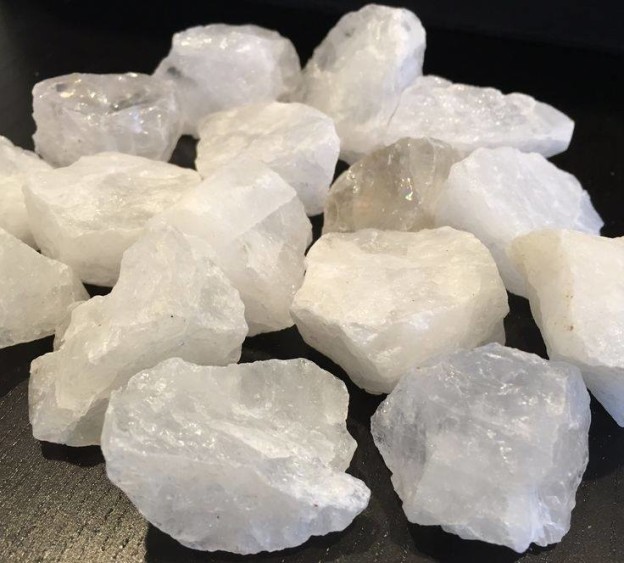There are many quartzes everywhere! In the mountains – this cement, fastening granites. In the deserts – this is all known sand. In the interior – this is the bedding of sandstone and quartzite. And even in the human body contains quartz! True, in the one-kilogram bodybuilding quartz there is only one gram, but who knows what the future evolution will lead to?
Physico-chemical properties of quartz
Crystals of quartz are oblong hexahedrons resembling sharpened pencils. Often grow friends. Small crystals of individual varieties of quartz can form massive brushes.
- Singonia is trigonal.
- The hardness is 7 on the Mohs scale.
- The density is 2.6 g per cm3.
- A break is a shell.
Pure quartz is silicon dioxide SiO2. In gemology, colorless and defect-free quartz crystals are called rock crystal and are considered an independent precious stone.
Impurities in quartz crystals are extremely numerous and diverse. Each of them changes the optical properties of quartz in its own way.
Kinds of quartz
Organic inclusions make quartz purple and turn it into an amethyst. But the ancient Greek legend warned: this Dionysus poured wine into a stone…
Iron is a common admixture in an array of crystallized silicon oxide. Trivalent iron causes quartz crystals to turn yellow. Gemologists call this stone a citrine. Quartz looks incredibly attractive, the admixtures in which are mixed in a miracle cocktail, giving the stone features and amethyst, and citrine at the same time. Ametrin – the name of this unusual “hybrid” – is quite expensive compared to other quartz relatives.
But not always only impurities form the appearance of a quartz crystal. Morion is black and opaque because of the increased energy potential of atoms located at the nodes of the crystal lattice. The greens of praziolite appear only because of a change in the light transmission of citrine and amethyst, provoked by an increase in the speed and amplitude of the Brownian motion of the molecules.
The listed varieties of quartz refer to the crystalline forms of the mineral. In nature, there are a lot of so-called cryptocrystalline rocks of the quartz group. All of them include quartz in the form of a base and a considerable number of complex additives – often cloven, scaly, and suspended.
Aventurine sparkles with myriads of sparkles of mica, iron or copper ore scattered over the quartz massif. Chrysoprase is fogged by alkaline nickel gel cells. Carnelian warms the red-brown glow of a solid solution of hematite in silicon oxide. The endless variety of agates and chalcedons is the best illustration of the compatibility of quartz and the most diverse mineral fillers.
Stone quartz – one of the first materials mastered by man
The oldest beads, collected from small quartz pebbles, number more than seven thousand years of age. However, the tools, carved from heterogeneous quartz, are five times older. Does this mean that humanity has abandoned quartz instruments in favor of Metaphysical jewelry?
Not at all! Thin cleavages of obsidian, almost entirely of quartz, are still used as scalpels – because it is difficult to sharpen steel to nanometer thickness of the cutting edge of obsidian.
Piezoelectric properties of quartz allow you to set and control the operation of high-frequency devices – including communication equipment and computers. Dielectric parameters of crushed quartz allow creating powerful and compact power stations.
Quartz and the glass industry can do without quartz. The products of which happen to be used to simulate precious quartz rocks…
Quartz forged!..
… But not always maliciously. Venetian glaziers created a beautiful blue glass and, inspired by the poetics of minerals, called it sapphirine. Meanwhile, sapphirin in mineralogy is magnesium aluminosilicate, and gemmologists call sapphirin one of the varieties of chalcedony.
What did the unscrupulous sellers take advantage of! The cut pieces of certified Venetian crystal are completed with printouts from mineralogical reference books or gemological bulletins – and sell inexpensive glass as a precious gem.
Pleased rare (in jewelery quality) pink quartz forged by staining conventional smoky quartzcompounds of iron and manganese. Dyes penetrate shallowly and not very evenly, so imitation sells cheaply (natural pink quartz of roads) and without guarantees. Rapid oxidation of metals quickly deprives the forgery of attraction and makes it get hot.
The healing and magical properties of quartz
Speaking about the healing and magical properties of quartz, one must understand that the practical qualities of ordinary wild stone (translucent, grayish, smoky-whitish) coincide in some ways, and in some ways differ from the possibilities of noble quartz.
Any quartz has a depressing effect on the microflora (rock crystal is the most effective). But if purple quartz (amethyst) helps to combat intoxication, then green (praziolite) acts more like a psychotherapist.
Do not forget that the surplus of silicon oxide in food, water and especially in the air – is harmful. Therefore, experiments with water infusion on quartz pebbles should not be fanatical. The amateur fission of quartz is performed only in a respirator!
Each of the signs of the Zodiac can pick up several colored quartz according to the recommendations of astrologers and their own attitude. There are no categorical prohibitions!

